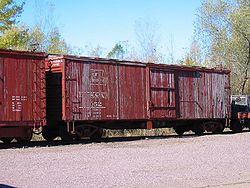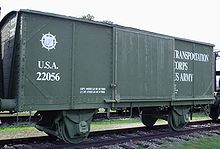- Boxcar
-
 A Duluth, South Shore and Atlantic Railway boxcar on display at the Mid-Continent Railway Museum in North Freedom, Wisconsin.
A Duluth, South Shore and Atlantic Railway boxcar on display at the Mid-Continent Railway Museum in North Freedom, Wisconsin.
A boxcar (the North American term; other terms include "goods van" (UK), "louvre van" (Australia), "covered wagon" (UIC and UK) or just "van" (UIC and UK)) is a railroad car that is enclosed and generally used to carry general freight. The boxcar, while not the simplest freight car design, is probably the most versatile, since it can carry most loads. Boxcars have side doors of varying size and operation, and some include end doors and adjustable bulkheads to load very large items.
Contents
Usage
Boxcars can carry most kinds of freight. Originally they were hand-loaded, but in more recent years mechanical assistance such as forklifts have been used to load and empty them faster. Their generalized design is still slower to load and unload than specialized designs of car, and this partially explains the decline in boxcar numbers since World War II. The other cause for this decline is the container. A container can be easily transshipped and is amenable to intermodal transportation, transportable by ships, trucks or trains, and can be delivered door-to-door. In many respects a container is a boxcar without the wheels and underframe. Even loose loads such as coal, grain and ore can be carried in a boxcar, with boards over the side door openings. In later times grain transport used metal reinforced cardboard which was nailed over the door and could be punctured by a grain auger for unloading. This was more common in earlier days; it was susceptible to losing much loading during the journey, and damaged the boxcar. It was also impossible to mechanically load and unload. Grain can also be transported in boxcars designed specifically for that purpose; specialized equipment and procedures are required to load and unload the cars.
 Helm Financial Corporation #60036, a double-door boxcar, passes through Prairie du Chien, Wisconsin on August 8, 2004.
Helm Financial Corporation #60036, a double-door boxcar, passes through Prairie du Chien, Wisconsin on August 8, 2004.
Livestock can be transported in a boxcar (which was standard practice in the U.S. until the mid-1880s), but there is insufficient ventilation in warm weather. Specially-built or converted stock cars are preferable. Insulated boxcars are used for certain types of perishable loads that do not require the precise temperature control provided by a refrigerator car. Circuses used boxcars to transport their workers, supplies, and animals to get from town to town.
 Santa Fe boxcar being loaded with a wing from the Spirit of St. Louis, example of an automobile boxcar.
Santa Fe boxcar being loaded with a wing from the Spirit of St. Louis, example of an automobile boxcar.
Historically automobiles were carried in boxcars, but during the 1960s specially built autoracks took over; these carried more cars in the same space and were easier to load and unload. The automotive parts business, however, has always been a big user of the boxcar, and larger capacity "high cube" cars evolved in the 1960s to meet the auto parts industry's needs. Special boxcars carry newsprint paper and other damage-sensitive cargo.
While not holding the dominant position in the world of railborne freight that they had before World War II, the boxcar still exists and is used in great numbers around the world.
Double door boxcar
A double door boxcar has two sliding doors on each side instead of one.
Hicube boxcar
In recent years "hicube" — "high cubic capacity" — boxcars have become more common in the USA. These are higher than regular boxcars and can only run on routes with increased clearance (see loading gauge and structure gauge). The excess height section of the car end is often marked with a white band so as to be easily visible if wrongly assigned to a restricted gauge line. [1]
Passenger and wartime use
 Interior of a boxcar used by Nazi Germany to transport Jews and other victims during World War II. The boxcar is located inside the United States Holocaust Memorial Museum in Washington, D.C.
Interior of a boxcar used by Nazi Germany to transport Jews and other victims during World War II. The boxcar is located inside the United States Holocaust Memorial Museum in Washington, D.C.
The boxcar has been used to carry passengers, especially during wartime. In both World Wars, French boxcars known as forty-and-eights were used as troop transports as well as for freight; in World War II by first the French forces, then the German forces, and finally the other Allied forces. In addition to soldiers, the Germans transported prisoners in crowded boxcars during the Nazi regime. The same transportation was used by the Soviet Union during the 1930s and 1940s, when over 1.5 million people were transferred to Siberia and other areas from different countries and areas incorporated into the Soviet Union.
The United States used troop sleepers to ferry U.S. soldiers through North America during World War II. These cars were both based upon boxcars and intended to be converted into boxcars after the war was over.
Hobos and migrant workers have often used boxcars in their journeys (see freighthopping), since they are enclosed and therefore they cannot be seen by railroad-employed security men ("Bulls") or police, as well as being to some degree insulated from cold weather.
The French called their troop-carrying boxcars "forty-and-eight" (quarante et huit, often written 40/8) because they were rated by the army as capable of carrying forty soldiers or eight horses. The name was adopted by veterans of such transport in forming the Forty and Eight veterans organization.
Preservation
 A picture of an ageing freight General Utility Vans (GUV) box car at Oxford station in the year 2001.
A picture of an ageing freight General Utility Vans (GUV) box car at Oxford station in the year 2001.
One of the largest collections can be found at the Western Pacific Railroad Museum at Portola, CA. The museum rosters over 30 boxcars, including several rare or unusual styles. The oldest dates from 1909, while several are from the 1960s and '70s.
See also
- Bockscar - World War II bomber
- Covered goods wagon - for European and UIC practice
- Freight cars
- Railbox
People
- Ernest E. Debs, Los Angeles County supervisor who emigrated in a box car to the West Coast as a young man
References
External links
- Akron, Canton and Youngstown Railroad #3024 — photo and short history of an example of an outside-braced wooden boxcar built by Mather Stock Car Company.
- Atchison, Topeka and Santa Fe Railway #276594 — photo and short history of an example of a typical modern (post-World War II) steel boxcar.
- Union Pacific Railroad #498769 — photo and short history of an example of a typical "billboard" boxcar.
- Guide to Railcars
Rail transport freight equipment Enclosed equipment Autorack · Boxcar (US) · Coil car · Container · Covered hopper · Covered wagon · Refrigerator car (US) · Refrigerated van (EU) · Roadrailer · Stock car · Tank carOpen equipment Flatcar · Gondola (US) · Hopper car · Open wagon (EU) · Modalohr · Schnabel car · Double-stack car · Mineral wagon · Slate wagonNon-revenue equipment Caboose (US) · Brake van (EU) · Work trains · Scale test car · Clearance car · Crane (railroad) · Rotary snowplowCategories:- Freight equipment
- Rail transport terminology
Wikimedia Foundation. 2010.


